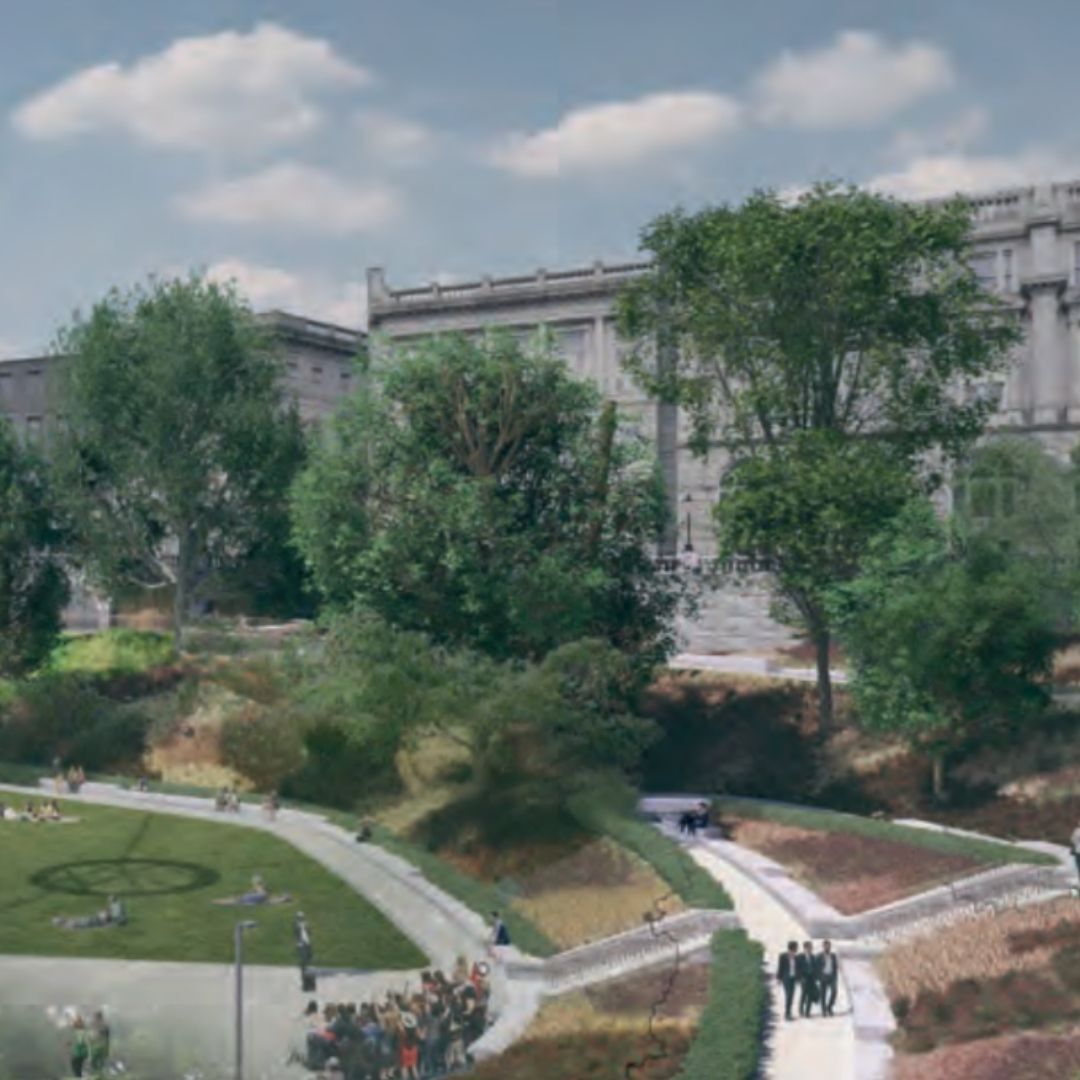Get updates from The Developer straight to your inbox Yes, please!
Union Terrace Gardens, Aberdeen, for Aberdeen City Council, with LDA Design, Stallan Brand, Arup and Balfour Beatty

Union Terrace Gardens is intended as a catalyst for further regeneration across 30 potential investment sites in Aberdeen. The £28.3m project equipped the sunken park with extensive seating, new lighting features, commissioned artworks, 122,000 plants, more trees, and the reinstatement of a planted city crest. The 2.5ha site has hosted various festivals and events that celebrate biodiversity and aesthetics of the gardens.
Who is on the project team? (designer, consultants, etc)
Landscape Architect: LDA Design
Architect: Stallan Brand
Engineer: Arup
Main Contractor: Balfour Beatty
Landscape Contractor: Ashlea Ltd
Describe the context of this project, its neighbourhood and people.
Aberdeen’s Union Terrace Gardens is one of the UK’s most important park regenerations. Situated in the heart of the city, the park was designed as pleasure gardens by the architects who built many of the listed granite buildings which surround it and for which the city is famous. The site is within the city centre conservation area and has always been central to the history and development of the city. The two and a half acre Gardens are in a steep river valley and so have a very striking topography for a city centre. They opened in 1878, designed with lawns, a grand granite staircase, fine statuary and formal planting. The decline of Union Terrace Gardens in the late 20th century reflected the wider deterioration in the condition of central Aberdeen. The Gardens became a magnet for serious anti-social behaviour and their future the subject of a bitter and divisive struggle across the city, given proposals included filling in the park valley with a shopping mall. The Friends of the Gardens won a hard-fought campaign. In 2016, a masterplan commissioned to drive regeneration of the wider city centre identified 30 potential sites for investment, but it was decided to invest first in the Gardens as the catalyst. LDA Design was commissioned by Aberdeen City Council to lead a multi-disciplinary team to reunite the city behind a new and inclusive design that would animate the Gardens while respecting their special Victorian charm and character.
How does this public space bring people together, encourage inclusivity, and make a positive environmental impact to the wider place? How is the community engaged in the project?
In Aberdeen, the restored Gardens have strengthened the connections between people and place. They have been reclaimed by young families, runners, walkers and skateboarders. Three pavilions provide spaces for cafés and cultural space, and neglected archways have been transformed into gallery spaces for small business use so the Gardens are well-used during the evening as well as the day. Of highest priority was to make sure the Gardens worked for all ages and abilities, particularly challenging given the extreme site topography. Accessible routes were developed in close consultation with disability groups. The Chair of the Disability Equity Partnership described the plans as one of the best examples of inclusive design they had ever seen. As a high profile pilot within the wider City Centre Masterplan strategy, the Gardens aim to revitalise the city centre, to deliver prosperity and a better quality of life for all. Investment of £28 million in the Gardens demonstrates the City’s faith in the power of green space to catalyse regeneration and now a further 50 projects are starting to tackle environmental issues in the area, and to create a more equitable place with less social isolation and better health and wellbeing. The original redesign was informed directly by community views, so for example the central lawn has capacity for sizeable events, and there is a wide range of play equipment, the Gardens will evolve in response to how they are used.
Please share any data or figures that support your entry about how this public space or landscape intervention has made a positive social or environmental impact, for example biodiversity, increased dwell time, flood or drainage mitigation, wellness or safety or other ecosystem services
The Gardens hosted much of Aberdeen’s winter festival of light, Spectra 2023, which attracted 119,000 visits across four days, remarkable in a city of just over 250,000 inhabitants in chilly February. This is estimated to have generated media coverage valued at over £6million to the city and established the Gardens as a focal point for large arts events and an important economic driver in the city centre. Safety was a priority in the redesign and there is a sophisticated lighting strategy to make the Gardens inviting to all. The new connections to surrounding streets, formed of bridges and elevated walkways, allow for increased passive surveillance, opening up the Gardens and enhancing city centre views. The Biodiversity Enhancement Plan described the previous Gardens’ baseline as being of low ecological value for habitats. Enhancement measures include the creation of wildflower areas, shrub borders, additional trees, and the installation of artificial refugia. Lighting, which has been implemented to the highest environmental standards, includes careful consideration of nature. A tapestry of over 122,000 mixed plants, including a high proportion of natives, replaced a monoculture of amenity grass on the Gardens’ steep slopes. Trees and shrubs have been distributed to create habitat corridors, allowing movement through the gardens. Eighty-eight new trees of mixed species were planted within the Gardens to improve biodiversity and to mitigate future bio-security threats. Half of these trees have a carbon sequestration A rating. The trees will store 349,413 kg of carbon at maturity.
Sign up to our newsletter
Get updates from The Developer straight to your inbox
Thanks to our organisation members
© Festival of Place - Tweak Ltd., 124 City Road, London, EC1V 2NX. Tel: 020 3326 7238